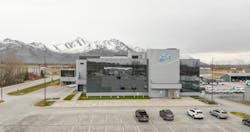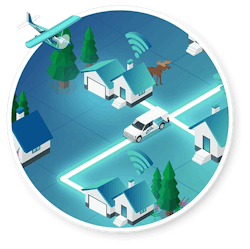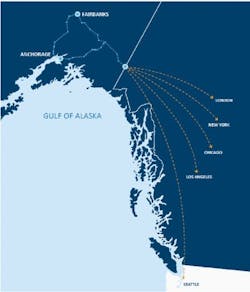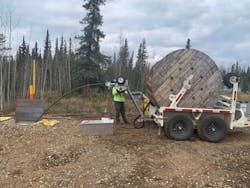Matanuska Telecom Association (MTA) focuses on connecting the unconnected with fiber broadband
As a locally owned telephone cooperative, Matanuska Telecom Association (MTA) has set an interest in the growth and success of our members and the areas it serves. This service-centric focus is centered in its consumer fiber-based broadband and middle mile network efforts.
Unsurprisingly, the key priority for MTA is to expand broadband throughout its territory, focusing on fiber-based services.
With the FCC's Alaska Plan set to be extended until 2034, MTA is addressing the realities of its impact and what life would look like without high-cost support for residential members.
MTA began in the early 1950s to improve communications in the Matanuska Valley via telephone service. At that time, Matanuska was primarily a farming and coal mining community, with less than 1,200 people, and reliable phone service was a rare commodity.
Michael Burke, CEO of MTA, said it’s an “exciting time” to be leading the 70-plus-year-old telco.
However, since MTA is in Alaska, its building season is limited. Therefore, it is done within the constraints of the region.
“We have a compressed construction season, which in Alaska is about five months from May to October,” Burke said. “You try to cram as much as you can into those five months and get it done.”
Pursuing funding options
Like other broadband providers, MTA is keen to participate in the Broadband Equity, Access, and Deployment (BEAD) program. In June 2023, Alaska was notified that it was allocated $1 billion in BEAD funding to connect Alaskan communities underserved by broadband.
The provider is waiting for Volume Two of BEAD. Once MTA reviews the FCC’s requirements for applying for BEAD funding, it will formulate a plan.
“You have the BEAD program here, which is on the cusp of funding rolling out, and there are other grant programs that are happening,” he said. “Plus, you have the focus companies have had on deploying broadband."
MTA is looking at various grant platforms.
The provider has been leveraging FCC ReConnect grants to build broadband and is coupling it with its investments.
It secured a grant from the United States Department of Agriculture (USDA) for its ReConnect Program, which focuses on building broadband infrastructure in rural America.
“We’re still actively pursuing ReConnect grants and others out there, so we’re exploring all of the options to extend broadband to more rural areas,” Burke said.
FTTH transition
While pursuing government funding is part of its buildout process, MTA continues to expand fiber broadband to more locations.
“Outside of the grant process, we have been investing in fiber-to-the-home and connecting thousands of locations with broadband every year in our service territory,” Burke said. “There’s a lot of activity in our serving area.”
While MTA’s transition to fiber-based broadband is the cooperative's newest priority, it indicates its strategy to care for its community.
Unlike traditional telcos that are beholden to shareholders, MTA is member-owned.
“Our owners are local and are our neighbors and people living in our community,” Burke said. “We’ve always been proactive with a focus on being on the leading edge of technology.”
He added that the key focus is “meeting the member-owners' needs.”
Fiber-based platforms can serve current and evolving bandwidth needs.
Today, current FTTH platforms like XGS-PON can support 10 Gbps. However, the movement toward 50—and even 100 Gbps PON is underway—highlighting how the broadband industry looks forward to meeting new speeds.
Burke likens MTA’s fiber movement to how a landscape architect plants foliage that they can't quite see when someone sees it for the first time, they can’t quite see. However, when it fully grows, it becomes an artistic rendering that the landscaper had when they planted it.
“Fiber is an essential tool in terms of the future because it’s a piece of facility that we can put in place that’s future-proofed,” Burke said. “It can last for decades into the future and is scalable for whatever level of service those customers may need five, ten and 30 years, so our focus is to build this future-proofed, adaptable network.”
As a traditional service provider with a long copper wiring legacy, MTA retains both copper and fiber throughout its network.
However, the provider is working to replace copper with fiber as it can.
“We’re working fast to overbuild all of the copper with fiber,” Burke said. “We are probably a few years out before we have fiber, but we have that five-month construction window, so it takes two to three times as long to make it happen.”
Prioritizing FTTH builds
When MTA is building out FTTH service, the provider, working within its limited time frame, will initially prioritize builds in areas that today only have copper-based DSL service.
“We try to focus on people with slower service,” Burke said. “The areas where we can’t do fast service, we try to build those out as fast as possible.”
He added that MTA builds out from a central point.
“Some are being built out that already have fast broadband, but they are on the way to get to remote locations in your area.”
While BEAD could accelerate its pace, Burke said it is “focusing on areas that have slow service or no service for quite a while now.”
A middle-mile vision
However, the last-mile consumer FTTH network is only one part of MTA’s fiber network vision.
The service provider continues to enhance its middle mile fiber network.
One of the unique elements of its middle-mile fiber network is that it can reach the rest of the United States. In 2020, MTA completed its AlCan ONE project, the first all-terrestrial fiber line connecting Alaska to the Lower 48 states, adding a leg to Chicago in 2022.
The line runs nearly 300 miles from North Pole, Alaska, to the Canadian border before connecting with Canadian carriers. This helps to extend MTA's existing network through Canada and onto significant hubs in the United States.
In 2022, MTA saw an opportunity to deepen its connections to the Lower 48 by extending the AlCan ONE project, bringing an additional secure, geographically diverse, high-speed connection to the Ma-Su Valley. This extension allows MTA to meet the need for fast and survivable telecommunications to the Midwest and East Coast while putting to rest any chance of a disaster or crisis cutting Alaska off from the rest of the U.S.
Traditionally, all transport was submarine cable from South Central Alaska to the Pacific Northwest. These connections crossed the Ring of Fire Alaska and the Pacific Northwest.
“The Ring of Fire is a geologically active area that can create fiber breaks,” Burke said. “Creating this redundant route terrestrially down through Canada provides protection and assurance that if something happened on those cables in Alaska, we could keep traffic flowing.”
Like the two railroad links built in Alaska in the 1850s to connect the East and West Coasts, the AlCan ONE project is about providing new fiber network connections for today’s digital age. In Alaska, the last big infrastructure project was the construction of the AlCan Highway, which was completed during World War II.
As part of this project, MTA built fiber down the Northwest border, and Canadian provider Northwestel built fiber from the other direction. The two providers interconnected their fiber network at the Canada/U.S. border. It then established connections from Alaska down to Seattle and connections to Chicago and other locations.
What’s also compelling about this network is its options for other businesses or service providers to access different markets and back into Alaska.
“This network connects Alaska by land to the rest of the country,” Burke said. “Because we go down to the data center meet points in the lower 48, we can connect into fiber networks nationwide. So, anyone with a fiber connection in Chicago, Seattle, or anywhere can connect to our network and come to Alaska and vice versa.”
Rural communities will also benefit.
One of the other benefits of its middle-mile efforts is also being felt in rural communities. This is because the network is built along the AlCan One Alaska Canada Highway, wh.
“There are some tiny communities along there that did not have that middle mile transport,” Burke said. “Because we built that network, these communities are now connected to the world.”
Closing the divide
One event that showed the importance of broadband was the recent COVID-19 pandemic, which forced traditional workers, including the MTA staff, into telecommuting.
On March 16th, 2020, MTA implemented remote work for as many employees as possible. The provider closed retail locations the following day and eliminated in-home services to protect its staff and member-owners.
Within two weeks, 90% of its workforce was working remotely.
At that time, NTA supported the “Keep America Connected” Pledge, which urges providers to waive late fees and not terminate service to customers facing economic hardship due to COVID-19.
It also partnered with the City of Wasilla, Palmer, Houston, and the Mat-Su Borough to install drive-in Wi-Fi hotspots so those without internet at home can connect, as well as an eLearning Enablement program that provided nearly 3,000 free upgrades to students and educators as they transitioned to distance learning.
“Companies had to take an extra step to support their communities,” Burke said. “Like so many companies, we had to have employees work from home.”
He added that this effort was also centered on the members it serves. “At the same time, we had to support the community and do the same thing,” Burke said. “Everyone worked from home and depended more on those broadband services.
Broadband customer bonds
As it advances its vision of broadband being an essential component for the state and the communities it serves, MTA is looking at ways to strengthen its bond with customers inside the home.
Overall, the service provider sees itself as a guide for its customers, helping them understand how to use and connect devices inside the home.
For one, MTA is looking to offer more network security products. This comes as more consumers face online threats from hackers who lure victims into financial scams.
“We’re seeing more and more interest in cybersecurity,” Burke said. “These broadband networks we’re deploying are not just providing a service but are providing some layers of protection and security.”
Its home network security platforms focus on the Wi-Fi routers it deploys to allow consumers to distribute services.
MTA’s managed Wi-Fi product has built-in security features. “Our managed Wi-Fi product has security attached to it because we keep hearing stories of consumers’ Wi-Fi routers being hacked and used by criminals,” said Burke. “This has driven us to help improve the customer experience.”
For related articles, visit the Broadband Topic Center.
For more information on high-speed transmission systems and suppliers, visit the Lightwave Buyer’s Guide.
To stay abreast of fiber network deployments, subscribe to Lightwave’s Service Providers and Datacom/Data Center newsletters.
FCC extends Alaska Plan
The FCC adopted the Alaska Plan Order in 2016. This order freezes $1.5 billion in funding over ten years and allocates that money to maintain, extend, and upgrade broadband service across some regions of Alaska. Ultimately, fifteen rate-of-return carriers and eight wireless affiliates elected the Plan. The Alaska Plan is set to be extended until 2034.
To track carriers’ access to these facilities, the Commission adopted a reporting requirement. The Commission described the data to be collected variously as “backhaul,” “middle-mile,” “backhaul and middle mile,” and “fiber network maps [and] microwave network maps.” The Commission required carriers to submit data for such maps “in a format specified by the Bureaus” and to update these maps annually if the carrier deployed such facilities in the prior calendar year “that are or will be used to support their service in eligible areas.”
About the Author
Sean Buckley
Sean is responsible for establishing and executing the editorial strategy of Lightwave across its website, email newsletters, events, and other information products.





